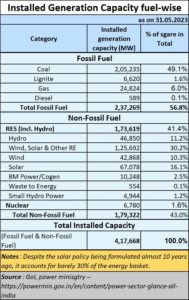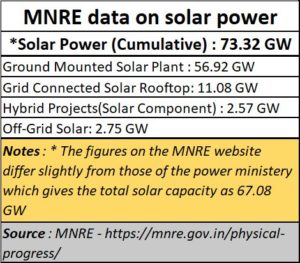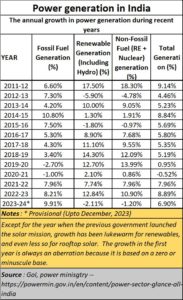Everybody in government likes to talk about solar power, but little more
By RN Bhaskar
The above image has been generated using Bing.
On 24 January 2024, Prime minister Modi announced (https://indianexpress.com/article/explained/modi-launches-new-rooftop-solar-scheme-pradhan-mantri-suryodaya-yojana-9122514/) the Pradhan Mantri Suryodaya Yojana (loosely translated as the Prime Minister’s Sunrise Scheme, or the Prime Ministers merciful sun scheme). It promised to offer rooftop solar to 1 crore (10 million) households. A day earlier, the Union Minister for New & Renewable Energy and Power stated that the compounded average rate of growth (CARG) of rooftop solar was 46%. Both were impressive statements. The claim needs to be viewed in the perspective of what has happened in the solar sector in India.
Moreover, India has 28 crore homes (assuming 5 people to a household for a population of 140 crore people). So effectively, the government is creating a scheme for just 3.5% of its homes.
It is worth narrating the history of solar power in India. On 11 January 2010 (https://www.seci.co.in/page/government-initiatives) the previous prime minister, Dr. Manmohan Singh announced the Jawaharlal Nehru National Solar Mission (NSM) with a target of 20 GW by 2022. The original target of 20 GW was surpassed in 2018 (counting only utility installed capacity), four years ahead of the 2022 deadline.
The target was increased to 100 GW by the succeeding government under Narendra Modi in its 2015 Union Budget. Except for the first year after the announcement of the NSM, the growth of solar power (including all renewables) has been relatively muted.
When one looks at a breakdown of the total installed capacity for the power sector, the share of solar becomes even more noticeable. The share of solar is under 20%
 What people often forget is that solar power makes immense sense for a country like India because the potential is huge.
What people often forget is that solar power makes immense sense for a country like India because the potential is huge.
 India has the potential for generating 749 GWP (GiggaWatt Peak) each year. Yet, the total installed capacity for solar is 73 GW (see the MNRE figures below).
India has the potential for generating 749 GWP (GiggaWatt Peak) each year. Yet, the total installed capacity for solar is 73 GW (see the MNRE figures below).
Moreover, the most promising states are
- Rajasthan (142 GWP)
- Jammu & Kashmir (111 GWP).
 Yet the largest installations can be found in other states like Gujarat and Mahrashtra, in addition to Rajasthan. Jammu & Kashmir and other states which show a higher potential than Gujarat have been ignored. Clearly, the government has not set its solar priorities right for different states. And while J&K may not have enough consumers, other neighbouring states can ‘import’ power from this state, in much the same way we import electricity from neighbouring Bhutan.
Yet the largest installations can be found in other states like Gujarat and Mahrashtra, in addition to Rajasthan. Jammu & Kashmir and other states which show a higher potential than Gujarat have been ignored. Clearly, the government has not set its solar priorities right for different states. And while J&K may not have enough consumers, other neighbouring states can ‘import’ power from this state, in much the same way we import electricity from neighbouring Bhutan.
In fact, the thrust to rooftop solar first came in 2016. This was stated in the keynote address by Upendra Tripathy, Secretary, Ministry of New and Renewable Energy, Government of India in July 2016 (https://1drv.ms/b/s!Ai_jJzsIjNyLjrQpvIFFAs83V9s0_A) at a discussion on solar power organised by both the Indian Merchants’ Chamber and the Free Press Journal (https://www.freepressjournal.in/fpj-imc-forum/spotlight-on-solar-energy).
All the panelists were agreed that — of all the types of solar power that India can harness — the benefits accruing from rooftop solar can be mindboggling. But Indian policymakers have given rooftop solar a quiet go-by. They wax eloquent about this type of power. But their heart is not where their mouth is.
This is in site of the fact that decenralised rooftop solar can create as many as 83 million jobs within a few years (https://asiaconverge.com/2017/10/solar-power-couldtrigger-employment-generation/). At a time when unemployment is severe, the government should have embraced this opportunity with both hands. Something appears to have prevented both the prev ious government and this one from doing so.
As Tripathy explained then, “We got this idea of a global investor meet for renewable energy, and ‘Re-Invest 2015’ was born (though it finally happened in February 2016) . . . One of the outcomes was that if land was an issue, we could take out 40,000 MW of this [the overall target] and put that on rooftops, which would not require land.”
Another strategy was to begin using the rooftops of government buildings. Said Tripathy, “Today, we have solar usage commitments from 45 secretaries of the Government of India across ministries, aggregating 5,000 MW. The atomic energy ministry committed for 50 MW and even, the department for personnel and training has a commitment for 2 MW.” But beyond the expressions of interest, many government offices have yet to implement rooftop solar as aggressively as they ought to have.
On March 11, 2018, the Prime Minister of India, Narendra Modi and the President of France, Emmanuel Macron co-hosted the founding conference of the International Solar Alliance (ISA). 48 countries, including 25 Heads of States participated in this conference. In addition, there were representations from the United Nations, multilateral development banks, energy-related think tanks, corporate sector and civil society ((https://pib.gov.in/Pressreleaseshare.aspx?PRID=1548295). Once again, there was a promise to promote solar, even rooftop solar. But little has happened in India on this front.
Tripura’s rooftop solar
The next big boost rooftop solar got was in Tripura in 2017. To understand this, listen to what the former chief minister of Tripura told this author in 2019 (https://asiaconverge.com/2019/03/biplab-kumar-deb-has-big-plans-for-tripura/). It relates to his decision in 2017 to provide 50,000 households with free solar power at the state’s expense. He said, “Then take the Saubhagya scheme under which each rural household should get electricity (http://saubhagya.gov.in/). Under this, the poor must get free electricity connection. Almost 60% of the people in this state are tribals. These people live in clusters of one family or four families – spread out over vast territories. Connecting spread out communities is quite expensive. If we provide connections through wires over pillars the cost per household goes up to Rs2-3 lakh per connection. So, our state had discussions with the union minister for power, RK Singh. We explained to him that there are around 50,000 households of tribals which are in remote and dispersed locations. We decided to supply them power through (decentralised-off-grid) solar connections instead – each costing around Rs.50,000. Wires would have been costlier. It also leads to theft and irregular supply. We have supplied solar power connections to 50,000 families, and as of 27 November 2018, we have provided electricity connections to 1.37 lakh households.”
The Tripura experiment was so successful that all the other North-Eastern states in India began clamouring for rooftop solar. The groundswell kept increasing. For one, rooftop solar was more reliable than grid power – there were no power cuts or load shedding. Second, there was no need to bribe linesmen to ensure that users got electricity during critical hours for farming or household chores. For state governments too, there was no annual subsidy for providing free power.
By November 2021, the clamour for rooftop solar became so shrill that even the Adani group decided to focus on this region (https://www.uniindia.com/~/adani-solar-partners-with-ksl-cleantech-to-expand-in-india-s-northeast/Business%20Economy/news/2571722.html).
Then why did rooftop solar not become popular across India?
Solar farms have other attractions
One reason why big utility grade solar farms became popular is because they could produce consistent supply of power that could be fed into the grid. Decentralised rooftop solar produce intermittent power, which must be first aggregated, then ‘cleaned’ (through inverters and similar equipment), and then fed into the grid. This is what Germany’s Hermann Scheer did by focussing on a middle layer (https://asiaconverge.com/2016/04/india-not-learn-germanys-hermann-scheer-solar-power-model/). It was this middle layer that helped create jobs, and actually bring benefits of rooftop solar to the entire nation. It seems that the Indian government did not want to take up this heavy lifting exercise, even though it would benefit the country.
Another reason is that rooftop solar renders redundant the government’s penchant for granting subsidised power year after year to favoured constituencies. Once you have rooftop power, you don’t need government subsidies. That is what politicians do not like. Hence their aversion for rooftop solar.
But the biggest attraction, say experts, is that large scale solar farms offer a subtle way for land grab. The state allowed large tracts of land to be used for solar farms. That takes away land which has several uses in India, which is already quite populated (https://www.business-standard.com/opinion/columns/land-and-the-problem-of-inequity-124020801757_1.html). Land comes at a premium, and solar farms allow land to be acquired cheap. It is only a matter of time, when the solar panels can be lifted 20 feet above the ground, and warehouses (or whatever else) can be built below.
The Suryodaya Yojana
It is good that the government is now talking about rooftop solar again.
But there are some vexing questions.
- Why only one crore? Why not for the entire country?
- What about creating a middle layer? Tata Power has done this successfully, in which could be described as the world’s largest sustainability project (https://asiaconverge.com/2021/12/tata-power-is-setting-up-the-worlds-largest-rural-electrification-sustainability-project/). Why hasn’t the government adopted this model as a template for the rest of rural India?
- There are some questions about the cost at which rooftop solar is to be provided under this scheme. Tripura showed that the cost was Rs.50,000 per rooftop installation. Since then, solar panel costs have continued to tumble. Tony Seba, noted strategist, believes that they will continue to tumble till 2030 (https://www.youtube.com/watch?v=7eJKTYc_v-I) to around one tenth of even the current low levels. That is why it is with alarm that one reads some media reports that have said that “Installation costs range from Rs 2.20 lakh to 3.5 lakh for a 3KW – 5KW system” (https://www.businesstoday.in/personal-finance/top-story/story/pradhan-mantri-suryodaya-yojana-what-is-the-cost-of-installing-rooftop-solar-panel-check-subsidy-break-even-financing-and-other-details-414653-2024-01-24). The country needs a white paper on normative costs for rooftop solar urgently.
Conclusion
The Suryodaya Yojana is welcome, because it puts the spotlight back on rooftop solar. That could generate employment. It could also make the government’s schemes for free or subsidised grid power redundant. But a lot more work needs to be done. Most important is the need to create a middle layer. India’s policy makers need to get back to work.







































COMMENTS